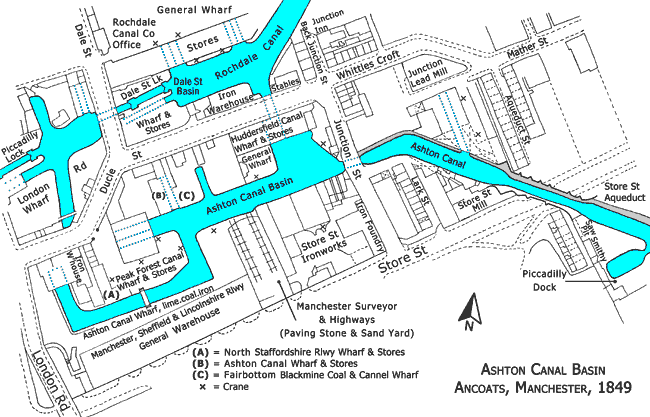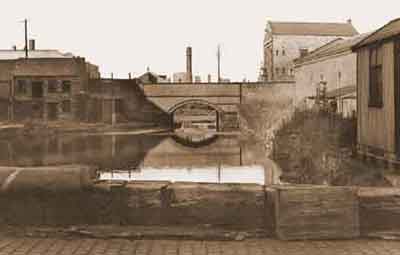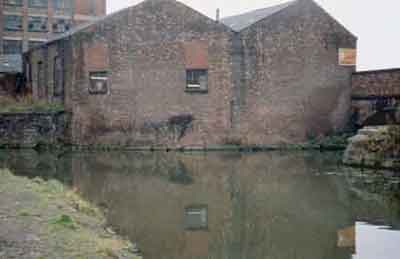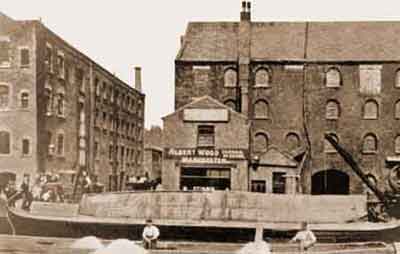
The most important concentration of canal basins and wharfs in Ancoats was situated south of Great Ancoats St (formerly Ancoats Ln). The area between Great Ancoats St and Ducie St/Whittles Croft/Mather St was occupied by the Rochdale Canal Company whose broad canal into Piccadilly, Manchester from Sowerby Bridge, Yorkshire and through to the Bridgewater Canal at Castlefield opened in 1805. Here a number of large warehouses were built around Rochdale Canal Basin, the most important of which lay between the basin and Back China Ln, off the map to the north.
To the south of Ducie St/Whittles Croft/Mather St was Ashton Canal Basin, opened by the Ashton Canal Company in about October 1797. This narrow canal provided an alternative route into Yorkshire by way of the Huddersfield (Narrow) Canal and Standedge Tunnel. It was onto the Ashton Canal that limestone, lime and gritstone from the Peak District of Derbyshire was brought via the Peak Forest Canal and Tramway. The Ashton Canal was an important link in the canal network around Manchester and when the Macclesfield Canal opened in 1831 a more direct route from the Midlands and Potteries, via the Peak Forest and Ashton Canals, was established. In the same year, the Cromford and High Peak Railway, connecting the Cromford Canal at Cromford to the Peak Forest Canal at Whaley Bridge was opened and this provided an alternative route from the Midlands.
On the 1 January 1847, the Ashton, Peak Forest and Macclesfield Canal Companies became part of the Manchester, Sheffield and Lincolnshire Railway Company and the railway company built a large warehouse on Store St.
Associated with the Rochdale and Ashton Canals, were a large number of wharfs for the storage of bulk goods, such as coal, limestone, gritstone, sand and timber. By 1849, the new railway network was growing rapidly but the canal network was still important for cheap, bulk transport, especially as roads were then incapable of moving bulk goods over long distances.

 |
 |
Ashton Canal Basin, 1960. This view shows Junction St (now Jutland St) crossing the canal with Ducie St and Store St off the picture to the left and right, respectively. Off to the left, the canal passes below Ducie St to enter Ducie Street Basin of the Rochdale Canal. Through the bridge hole the canal veers to the right to cross Store Street Aqueduct. In the background, just above the bridge parapet, Bradford Gas Works is just visible. |
Dale Street Basin, Rochdale Canal, early 1980s. The bridge on the right carries Ducie St over the canal and it is the entrance to Ashton Canal Basin from Dale Street Basin of the Rochdale Canal. |
 |
Peak Forest Canal Wharf, Ducie St. This view shows the wharf and premises of Albert Wood who was a canal carrier offering a daily express service of boats along the Ashton, Peak Forest and Macclesfield Canals. The 2-chain survey of the Ashton Canal, dated 1889, identifies the premises carrying Albert Wood’s name-board as the ‘MS&LR Carrying Office’. The MS&LR withdrew its general carrying service in 1892 and Albert Wood took over these premises at an uncertain date afterwards, thus the photo possibly dates to 1892-1900. |